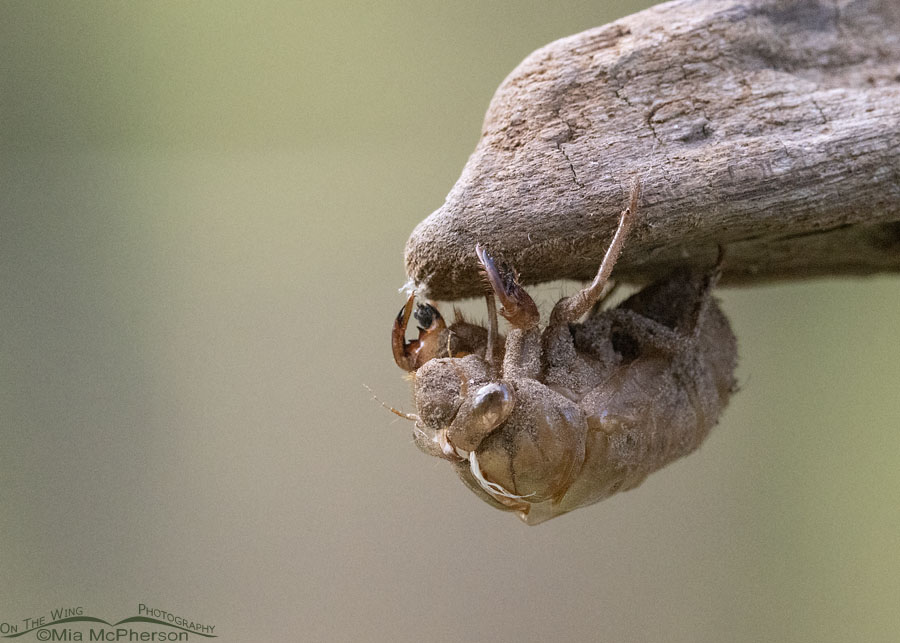Two days ago I found a Cicada exuvia or exoskeleton attached to a driftwood suet feeder. The cicada had emerged sometime during the night to begin its life anew.
 Cicada exuvia or exoskeleton in Arkansas – Canon R7, handheld, f10, 1/800, ISO 6400, Canon RF 100-500mm at 472mm, natural light
Cicada exuvia or exoskeleton in Arkansas – Canon R7, handheld, f10, 1/800, ISO 6400, Canon RF 100-500mm at 472mm, natural light
There are both annual and periodical cicadas and I have no clue as to the species of this particular cicada and I am fine with that. There are at least 24 species of cicadas in Arkansas and I really don’t have the time nor the energy to do much research on this cicada exuvia.
The exuvia is the shed outer covering of the nymph, which is the immature form of the cicada that lives underground. When the nymph reaches its final molt and transforms into an adult cicada, it emerges from the exuvia, leaving it behind clinging to a tree branch or other surfaces. The exuvia is often brown and brittle and serves as protection for the developing insect while it undergoes metamorphosis.
My little bit of research indicated that Arkansas is home to several species of cicadas, including both annual and periodical cicadas. The exact number of species can vary, but here are some common species found in Arkansas.
- Annual Cicadas:
- Tibicen spp. (Dog-Day Cicadas): These are large-bodied cicadas with species like Tibicen canicularis and Tibicen lyricen. They are often heard during the hot summer months.
- Periodical Cicadas:
- Magicicada spp.: Arkansas is part of the region where periodical cicadas emerge in massive numbers at specific intervals. The two primary periodical cicada species found in Arkansas are:
- Magicicada septendecim (17-year cicada)
- Magicicada tredecim (13-year cicada)
- Magicicada spp.: Arkansas is part of the region where periodical cicadas emerge in massive numbers at specific intervals. The two primary periodical cicada species found in Arkansas are:
These periodical cicadas are known for their synchronized emergence in large numbers, creating a spectacle called a “brood.” Different broods emerge in different years, and their distribution can vary across the state.
It’s important to note that the specific number and distribution of cicada species in Arkansas may be subject to ongoing research and discovery.
I like hearing cicadas and they have started to sing here and I am glad they have. I also like finding their shells.
Life is good.
Mia
Click here to see more of my Insect and Spider photos plus facts and information about them.


Great pic and fascinating info. The only cicadas I’m aware of here in Calif., are on the 17 year cycle. A few years ago my brothers and I were hiking in the Sierra’s during a huge cicada hatch and that was quite an experience. The sound seemed to fill every molecule of air around us. It was unbelievably powerful. If only we could shed our crusty old exoskeletons and re-emerge with beautiful new bodies. Hell, I’d sing like crazy too. Thanks Mia.
This is the coolest! I loved listening to cicadas when I lived in Illinois — one of those years was a brood year and there were so many! 🎵🎶
Interesting information and great photo. Looks demonic! I grew up in Virginia, and hot summer evenings fairly throbbed with their songs. I haven’t heard that in eons. Here in Northern CA we do have cicadas, I find their exuvia. But I guess they’re the silent variety, or else their pulses are outside our hearing range. I’ll have to look that up.
Neat image and explanation.-Jeri
It is years since I have heard their song. They seem to have disappeared here – which I mourn.